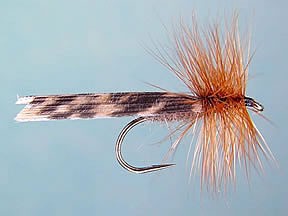
On The Fly
"Fly tying is a school from which we never graduate"
TYING NEWS
The Southern Oregon Fly Tiers met Wednesday, March 8th at the library in Gold Hill. There
was a fly raffle and fly challenge along with tying demonstrations. We had several new tiers drop by for a
fun evening. Our next meeting will be on April 12th. Join us the second Wednesday of each month for more
fun and the sharing of the art.
The Northwest Fly Tying Expo will be held again this year in Eugene on March 25th. Over
170 tiers from all over the northwest will be demonstrating their skills and talents at the fairgrounds
pavilion. Many fine fly tiers from our club will be involved in these demonstrations. The cost is minimal
for this all-day event. If you haven’t attended before, you’re missing the chance to learn more in one
place, in one day, than any other opportunity. I hope to see you there.
 PATTERN OF THE MONTH - Kings River Caddis
PATTERN OF THE MONTH - Kings River Caddis
Hook: Standard dry fly, sizes 12-18.
Thread: Brown or Black.
Body: Tan or brown fur to match the natural.
Wing: Mottled brown turkey wing quill.
Hackle: Brown or reddish brown.
Tying Instructions:
1) Start the thread behind the eye and apply an even thread base to a point just above the barb.
2) Dub a fairly bulky fur body about 2/3 shank-length long.
3) Cut a slip of turkey and tie it on top of the body (not in front of the body) by the thinner tip-end.
The wing should lay flat along body in a tent-like manner. Make the wing two shank-lengths long; clip the
wing to shape after it is secure.
4) Select a good grade dry fly hackle with barbs a little shorter than the standard 1½-gap widths. Secure
the hackle at the front of the wing and wrap the hackle to cover all of the thread wraps used to tie in the
wing.
5) Form a neat head, whip finish, and apply the head cement.
The Kings River Caddis was developed by the late Wayne “Buz” Buszek in the 1950s. He
worked out the pattern to match the caddis flies common on the Kings River and that hatched in droves in
the late evening. The pattern was successful locally, and soon its fame spread to other parts of the world.
Buz spread the word nationally through his own catalog. Orvis put it in their catalog and many fly-book
authors listed it. All of this gave it international exposure.
Buz’s contribution to fly tying are remembered in the Federation of Fly Fishers’ annual
Buz Buszek Memorial Award which is given to that fly tier who demonstrates outstanding skill, creativity or
innovation, and sharing knowledge by teaching or publication. It is truly a prestigious award. Since 1970
an amazing group of individuals have received it for their significant contributions to the art of fly
tying.
Let the naturals tell you how to fish this pattern. Use a floating line and dead drift the
fly if the fish are taking caddis that are floating along. If the fish are taking moving caddis, twitch the
fly a little. By tying the wing long, you can cut it shorter to match the caddis once you are streamside.
The Kings River Caddis is a fairly simple pattern to tie and has only three materials
besides the hook and thread. It has caught fish for over 50 years and will continue to fool them for at
least another 50 or more. This pattern deserves a place in your fly box. Tie some up for the coming season,
give them a test flight and let me know how they work.
TYING TIPS
As mentioned in the instructions, the wing is tied in at its tip rather than the thicker
section near the shaft. This way the wing does not split or flair. It is helpful to prepare the wing quill
by spraying it with an art fixative. The hackle is undersized so that the fly sets low on the water and the
wing stays parallel to the surface.
Tie One On,
Dan Kellogg (you can contact me at FLYGUY@EZNORTHWEST.COM)